How Long Should I Continue to Use Symbicort
Symbicort is used to treat the symptoms of asthma and COPD and to prevent them from recurring. Find out how to take it safely and possible side effects.
On this page, you can find the following information:
- What is Symbicort?
- How to use Symbicort for COPD
- How to use Symbicort for asthma
- Tips for when using your Symbicort Turbuhaler
- How to use your Symbicort Turbuhaler
- How to clean and store your Symbicort Turbuhaler
- How do you know when your Symbicort Turbuhaler is empty?
- Possible side effects
What is Symbicort?
Symbicort is a combination of 2 medicines, budesonide and formoterol, in a single inhaler.Symbicort is used to treat the symptoms of asthma and COPD and to prevent them from recurring.
- Budesonide is a corticosteroid. When inhaled, it prevents swelling and irritation in the walls of the small air passages in your lungs. It is also called a preventer, because when used every day it prevents shortness of breath and wheezing.
- Formoterol is a long-acting, fast onset bronchodilator. It relaxes and opens up your air passages, making breathing easier.
In New Zealand, Symbicort is available in different strengths: Symbicort 100/6, Symbicort 200/6 and Symbicort 400/12.

How to use Symbicort for COPD
If you are using Symbicort for COPD, it must be usedregularly twice a day every day as a preventer, to prevent flare-ups (your symptoms suddenly getting worse). It is called maintenance therapy for COPD. Read more about medicines for COPD.
How to use Symbicort for asthma
If you are using Symbicort for asthma, it can be used as a preventer and/or a reliever.
A reliever treats the immediate symptoms of asthma such as tightened airways. It starts to work in a few minutes.
Note, the high dose 400/12mcg strength Symbicort cannot be used as a reliever.
A preventer helps to reduce the risk of asthma attacks, by making the airways less sensitive to triggers and reducing inflammation and swelling in your airways.
Read more about medicines used to manage asthma.
Mild asthma
If you have mild asthma, you can simply use one puff ofSymbicort Turbuhaleras a reliever when needed for shortness of breath, without needing to use it regularly. This is called AIR therapy (anti-inflammatory reliever therapy).
Moderate to severe asthma
If you have moderate to severe asthma, you can use your Symbicort Turbuhaler as both a preventer and also as a reliever. This is called SMART (which stands for single maintenance and reliever therapy). This means that you can use your Symbicort Turbuhaler regularly each day for symptom prevention, and also when needed for symptom relief.
Preventer: Use Symbicort every day, once or twice daily.
Reliever: One inhalation when needed for shortness of breath. You can repeat as required, up to a maximum of 12 inhalations in one day. If you do need to take more and more doses each day, see your doctor to assess your therapy. Read more about the SMART action plan.
Tips for when using your Symbicort Turbuhaler
- Always use your inhaler exactly as your doctor has told you. The pharmacy label on your medicine will tell you how much to take, how often to take it and any special instructions.
- Symbicort Turbuhalers are available in different strengths. Ask your doctor or pharmacist which strength you are taking. If your inhaler looks different to what you were expecting, ask your pharmacist about this.
- Rinse your mouth after each use. Symbicort can cause a sore throat and hoarse voice. Rinse your mouth after each use to prevent this.
How to use your Symbicort Turbuhaler
To get the most benefit, it is important to use the correct technique when using your Symbicort. Ask your doctor, pharmacist or nurse to explain how to use your Turbuhaler. Even if you have been shown before, ask your doctor, pharmacist or nurse to explain how to use your inhaler if you still have any questions. Here is some guidance.
(Health Navigator NZ & Auckland District Health Board, NZ, 2018)
Using your Turbuhaler
| How to use your Symbicort turbuhaler | |
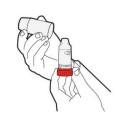 | Open: Unscrew and remove the cap. Hold the Turbuhaler upright. |
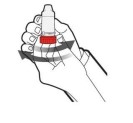 | Load the dose: Twist the base anticlockwise and then back in the other direction until you hear a click. Your Turbuhaler is now loaded with 1 dose of medicine. |
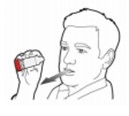 | Breathe out: Breathe out, away from the Turbuhaler. Do not blow directly into the Turbuhaler. |
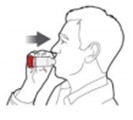 | Inhale your dose: Place the mouthpiece in your mouth and form a seal with your lips. Breathe in deeply. Remove the Turbuhaler and hold your breath for up to 10 seconds. |
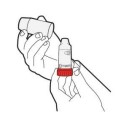 | Close: Replace the cap and twist until it is on properly. |
How to clean and store your Symbicort Turbuhaler
Wipe the mouthpiece with a clean dry tissue regularly, at least once a week. Don't use water or liquids when cleaning the mouthpiece or
any part of the Symbicort Turbuhaler.
Keep your Symbicort Turbuhaler in a cool, dry place with the cover firmly in place. Don't store it in the bathroom or near a sink. Keep the cap on when you're not using it. The device may clog up if you breathe out through it, dribble into it or keep it an place where there is high humidity (moisture in the air) with the cap off or unsealed.
How do you know when your Symbicort Turbuhaler is empty?
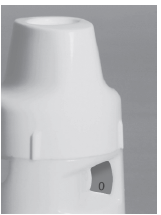 There's a window under the mouthpiece on the outside of the Turbuhaler called a dose indicator. The inhaler is empty when the " 0" on the red background has reached the middle of the window.
There's a window under the mouthpiece on the outside of the Turbuhaler called a dose indicator. The inhaler is empty when the " 0" on the red background has reached the middle of the window.
Note that:
- The dose indicator tells you how many doses are left in your inhaler.
- The dose indicator doesn't show each individual dose and moves slowly after 10 doses have been loaded. This means you may not notice movement for each single dose.
- When the inhaler is empty the loading grip will still move, but the dose indicator will stop moving once the inhaler is empty and the 0 on the dose counter will no longer change.
Possible side effects
Like all medicines Symbicort can cause side effects, although not everyone gets them. Often side effects improve as your body adjusts to the new medicine.
| Side effects | What should I do? |
|---|---|
|
|
|
|
|
|
|
|
| Did you know that you can report a side effect to a medicine to CARM (Centre for Adverse Reactions Monitoring)? Report a side effect to a product. | |
Learn more
Budesonide and formoterol NZ Formulary Patient Information
Symbicort Medsafe Consumer Information Sheets, NZ
References
- Budesonide + formoterol NZ Formulary
Source: https://www.healthnavigator.org.nz/medicines/s/symbicort/